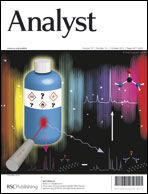A new surface-initiated polymerization based on pasting the initiator on a sensor chip surface was applied to prepare a malachite green (MG) imprinted ultrathin film on a surface plasmon resonance (SPR) sensor. First, the initiator (2,2-azoisobutyronitrile) was pasted on the gold surface using polyvinyl chloride (PVC). The initiator-covered gold chip was then soaked in a pre-polymerization solution prepared by dissolving methacrylic acid (functional monomer), ethylene glycol dimethacrylate (cross-linker), and MG (template) in DMSO in a weighing bottle. Finally, the weighing bottle was placed in a vacuum oven and thermal-initiated polymerization was conducted at 60 °C for 16 h. This method was simple and time-saving compared with the commonly used surface-initiated polymerization. More importantly, the molecularly imprinted polymer (MIP) film prepared using this method was much thicker than that of commonly used methods; the adsorption quantity was also much larger. The MIP modified SPR sensor showed high sensitivity and selectivity as well as good stability in detecting MG. The results suggest that the ultrathin MIP film prepared using the new method in this study is suitable to serve as the recognition element of the SPR sensor.

You have access to this article
 Please wait while we load your content...
Something went wrong. Try again?
Please wait while we load your content...
Something went wrong. Try again?


 Please wait while we load your content...
Please wait while we load your content...